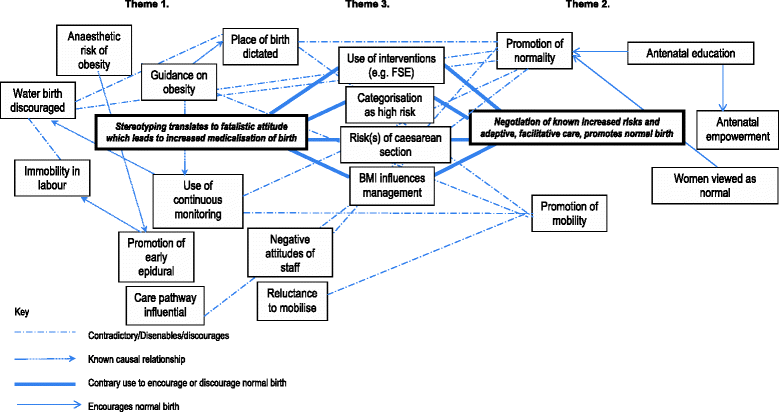Obesity and normal birth: A qualitative study of clinician's management of obese pregnant women during labour
- PMID: 26459259
- PMCID: PMC4603577
- DOI: 10.1186/s12884-015-0673-2
Obesity and normal birth: A qualitative study of clinician's management of obese pregnant women during labour
Abstract
Background: Currently one-fifth of women in the UK are obese. Obese, pregnant woman are at an increased risk of experiencing complications of labour and serious morbidity. However, they are also more likely to undergo medical interventions such as induction of labour and caesarean section which in themselves confer additional health risks for obese women such as wound infection and deep vein thrombosis. Reducing unnecessary interventions and increasing normal birth rates for obese women would substantially improve their postnatal health and wellbeing and reduce the burden of NHS resources required to care for them post operatively. This research aimed to explore practitioners' experiences of and strategies for providing intrapartum care to obese women.
Method: A qualitative methodology was adopted, focus groups and individual interviews were conducted with health professionals. Audio recordings were transcribed verbatim and data analysed using a framework approach.
Results: Twenty-four health professionals participated; Six Consultant Obstetricians two Consultant Anaesthetists and 16 midwives. Three key themes emerged from the data: medicalisation of obese birth; promotion of normal obese birth; and the complexities and contradictions in staff attitudes and behaviours. The overall interpretation is that positive approaches to obese birth offer opportunities to promote normal birth. However, many health professionals find the provision of intrapartum care to obese women challenging, and attitudes and behaviours towards the promotion of normal birth are heterogeneous, complex and contradictory.
Conclusion: The care of obese women during labour is generally medicalised and focussed on the associated risks. However, although there are conflicting views on how to care for obese women, some practitioners do strive to promote normality and optimise the potential for normal birth by challenging current practices and utilise some 'interventions' in order to facilitate normality and mobility during childbirth. Obesity is a major and growing health problem and a major cause of morbidity and mortality for pregnant women. It is essential that more positive proactive guidelines are available to maximise normal birth if the postnatal health of obese women is to be improved.
Similar articles
-
Being pregnant and obese: A qualitative study of the experiences of pregnancy and birth of women who are obese.Midwifery. 2025 Feb;141:104257. doi: 10.1016/j.midw.2024.104257. Epub 2024 Nov 29. Midwifery. 2025. PMID: 39637728
-
The experiences of midwives when caring for obese women in labour, a qualitative study.Midwifery. 2014 Jan;30(1):103-11. doi: 10.1016/j.midw.2013.02.008. Epub 2013 Apr 8. Midwifery. 2014. PMID: 23578585
-
Invisible but palpable- gender norms in childbirth : A focused ethnography on woman-midwife interaction and birth practices in two Swedish hospital labour wards.BMC Pregnancy Childbirth. 2025 Apr 10;25(1):419. doi: 10.1186/s12884-025-07554-8. BMC Pregnancy Childbirth. 2025. PMID: 40211247 Free PMC article.
-
Continuous support for women during childbirth.Cochrane Database Syst Rev. 2017 Jul 6;7(7):CD003766. doi: 10.1002/14651858.CD003766.pub6. Cochrane Database Syst Rev. 2017. PMID: 28681500 Free PMC article.
-
The German guideline "Obesity in pregnancy": comparison with the international approach.Arch Gynecol Obstet. 2024 May;309(5):1699-1705. doi: 10.1007/s00404-023-07314-z. Epub 2024 Jan 5. Arch Gynecol Obstet. 2024. PMID: 38180566 Review.
Cited by
-
Learning from Women with a Body Mass Index (Bmi) ≥ 30 kg/m2 who have Breastfed and/or are Breastfeeding: a Qualitative Interview Study.Matern Child Health J. 2019 May;23(5):648-656. doi: 10.1007/s10995-018-2679-7. Matern Child Health J. 2019. PMID: 30610528 Free PMC article.
-
Clinicians' views of factors influencing decision-making for CS for first-time mothers-A qualitative descriptive study.PLoS One. 2022 Dec 28;17(12):e0279403. doi: 10.1371/journal.pone.0279403. eCollection 2022. PLoS One. 2022. PMID: 36576912 Free PMC article.
-
Factors associated with cesarean birth in nulliparous women: A multicenter prospective cohort study.Birth. 2022 Dec;49(4):812-822. doi: 10.1111/birt.12654. Epub 2022 Jun 13. Birth. 2022. PMID: 35695041 Free PMC article.
-
Perinatal Outcome in Overweight Women: An Audit.Cureus. 2023 Oct 31;15(10):e48033. doi: 10.7759/cureus.48033. eCollection 2023 Oct. Cureus. 2023. PMID: 38034132 Free PMC article.
-
Identifying fundamental goals of childbirth care for women with higher body weight in Swiss maternity care: an embedded mixed methods multi-stakeholder study.BMJ Open. 2025 Jul 22;15(7):e086409. doi: 10.1136/bmjopen-2024-086409. BMJ Open. 2025. PMID: 40701595 Free PMC article.
References
-
- Central Intelligence Agency. Country comparison: Obesity – Adult prevalence rate. The World Factbook. 2015. Accessed at https://www.cia.gov/library/publications/resources/the-world-factbook/ra....
-
- Confidential enquiry into maternal and child health . Why mothers die 2000–2002. Midwifery summary and key recommendations. London: Royal college of obstetricians and gynaecologists; 2004.
-
- Centre for Maternal and Child Enquiries Saving Mothers’ lives: Reviewing maternal deaths to make motherhood safer: 2006–08. The eighth report on confidential enquiries into maternal deaths in the united kingdom. BJOG. 2011;118(Suppl. 1):1–203. - PubMed
MeSH terms
Grants and funding
LinkOut - more resources
Full Text Sources
Other Literature Sources
Medical


